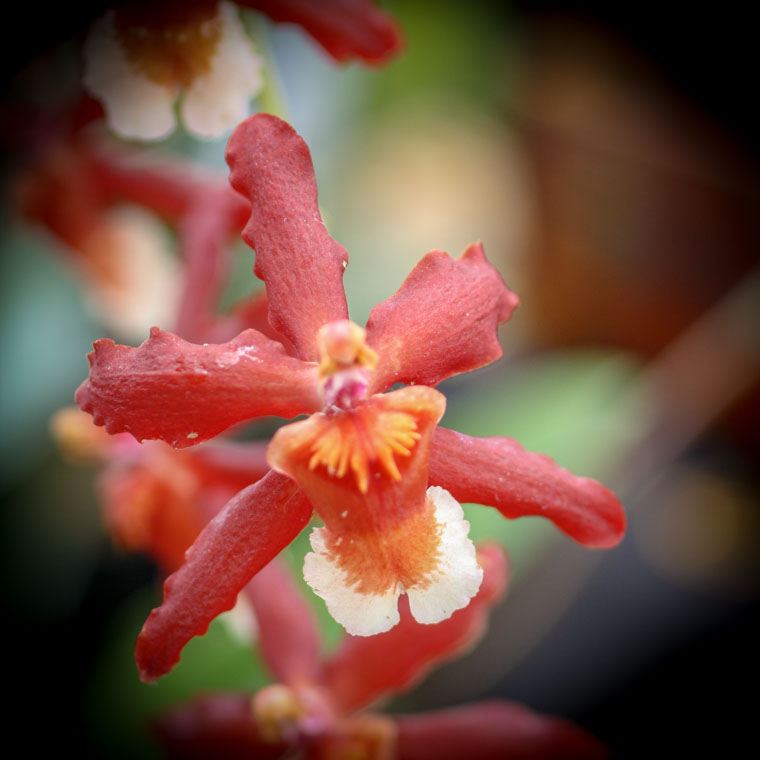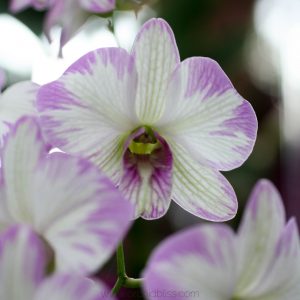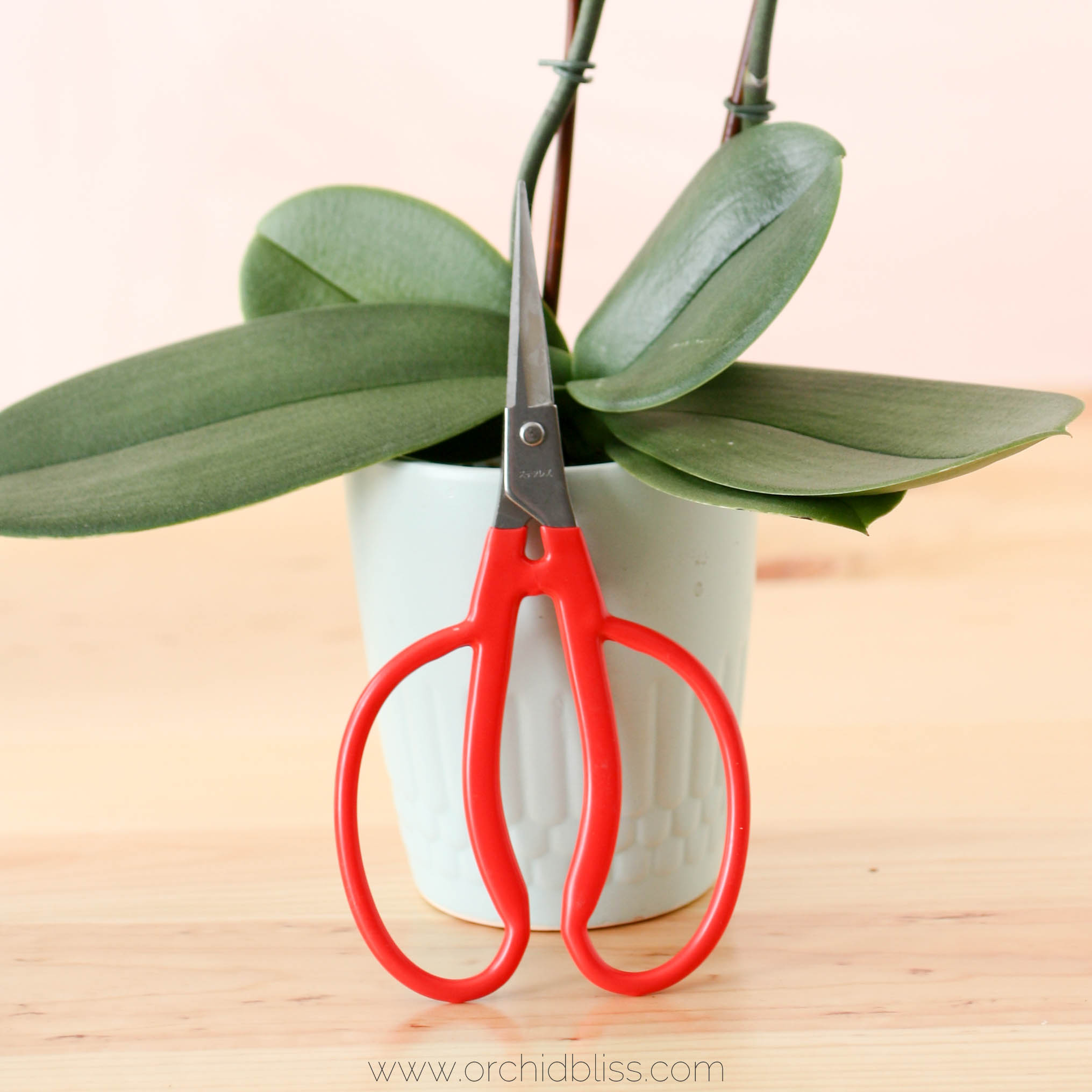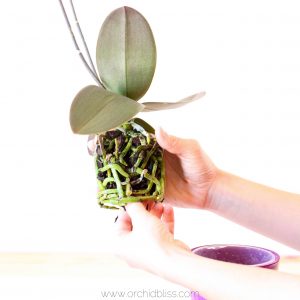
WINTER CARE FOR ORCHIDS
Of all the seasons, proper winter care for orchids can have the biggest impact on future flowers. These 8 tips will show you how to take care of orchids over the winter for beautiful, blooming orchids.

Some of the links on this page may be affiliate links. Click here to learn more.
#1 CHECK FOR BUGS AND WEEDS
When preparing orchids for winter the first item of business is to give them a thorough inspection to check for pests and pull out any weeds that may be growing in the potting media.
SLUGS & SNAILS
For outdoor orchid growers, slugs and snails can be a real nuisance, eating orchid roots and leaves. Sluggo is marketed as a safe, effective treatment.
APHIDS
Aphids love to suck the nectar from new growth. so look for them on new leaves, roots, and flowers. You can identify aphids by a cluster of soft-bodied insects on new, tender growth. To treat for aphids, (carefully) spray off your orchid with a blast of water from the hose. Then, follow up with insecticidal soap, rubbing alcohol, or neem oil.
SCALE
Also check for scale, which unfortunately is not as easy to get rid of as aphids. These insects can be both soft-bodied and armored. These little beasts hide wherever they can, including around the sheaths surrounding pseudobulbs. Really, scale can hide in every nook and cranny imaginable. Armored scaled, also called Boisduval scale form a hard crust that can be scraped off with your fingernail.
Treatment is the same for both hard and soft-bodied scale. Using an old toothbrush and 70% rubbing alcohol scrub down your orchid, focusing under leaves, around pseudobulbs, sheaths, and rhizomes. Then, treat repeatedly with horticulture oil.
MEALBYBUGS
Unlike scale, mealybugs do not glue themselves to their host and are easy to brush away. Mealybugs are also much easier to treat than scale. They look like white fluff and hide pretty much anywhere on the orchid. Treat with 70% alcohol if you find them. However, if mealybugs have infested the roots, you will need to use a systemic insecticide.
FUNGUS GNATS
If you see little black flies around your orchids, you probably have fungus gnats. Treat these pesky flies with predatory mites.
MITES
Spider mites and false spider mites are tiny orange-colored pests can be hard to see, but their results are not. If your orchid leaves are not smooth but instead have tiny indentations, your orchids likely have mites. To treat, use insecticidal soap or horticulture oil.
WEEDS
Now that you are bringing your orchids indoors, it is a good time to check the pots for weeds. Remove unwanted plants that may be growing in your orchid pots.
TIP: Moss is not a weed. Rather, moss is a sign that all is well – that you have a healthy growing environment.
Click here to read more about how to identify, prevent and treat orchid pests and diseases.
#2 DON’T THROW OUT A FROST-NIPPED ORCHID
If you waited too long to bring your orchid indoors and it was frost-nipped, don’t give up immediately. Give your orchid plenty of tender, loving care and it may survive.
Here’s what to do if your orchid has been frost-nipped:
- refrain from using fertilizer until the plant re-establishes itself.
- use care not to overwater
- keep plant away from drafts
- add extra humidity
- keep orchid away from direct sun
- give your orchid time to recover
#3 GIVE YOUR ORCHID THE RIGHT TEMPERATURE
How to keep orchids warm in winter: For many orchid enthusiasts, keeping our orchids warm enough throughout the winter months means bringing them indoors. For some orchids, the trick is to keep them warm enough, so that they don’t freeze, yet cool enough to trigger blooming.
TIP: bring orchids indoors once outdoor temperatures start dipping below 50°F/10°C.
Cooler temperatures are important for many orchids to initiate flower spikes. Phalaenopsis and Cymbidiums, for example, both benefit from cooler temperatures to trigger blooming.
Phalaenopsis, for instance, need temperatures for a few weeks down in the 50°s-60°s F/13° – 15.6° C. While Cymbidiums benefit from temperatures down in the 40°s F/ 4.4°-7° C to initiate flower spikes.
Providing your orchid with proper temperatures in the winter will help enable them to bloom later on. Follow the guide below to learn how much cold an orchid can take, and how much cold they need to rebloom:
Warm growers: between 65° – 85° F / 18.3° – 24.9° C. Give these orchids winter lows between 65° – 70° F / 18° – 21° C and summer highs around 85° F / 29° C.
Intermediate growers: between 60º – 80°F / 15.5° – 26.6° C. For optimum care provide these orchids with winter lows of 58°-62° F / 14.4° – 16.6° C and summer highs in low 80s° F / 27° C.
Cool growers: between 50° – 75° F / 10° – 23.9° C. These orchids prefer winter lows around 50° F / 10°C and summer highs around 80°F / 26.6° C.
Surprisingly, sometimes the trick isn’t how to keep your orchids warm in winter, it is how to keep them cool enough when it’s too cold outside and too warm inside. For this reason, cool-growing orchids may be out of bounds, and that’s okay. Stick with orchids that you can provide them with proper temperatures.
#4 PROTECT YOUR ORCHID FROM COLD TEMPERATURES – EVEN INDOORS
Cold winter temperatures may seep through the glass if you are growing your orchid near a window sill. A simple remedy is to pull the curtains closed at night. This is likely enough of an insulated barrier to protect your orchids.
Indoor growers need to keep their orchids a safe distance from heating and cooling vents, as well as exterior doors. This will protect orchids from drying air and cold temperatures. Humidifiers are a good idea, especially during dry winter months.
#5 MAKE SURE YOUR ORCHID HAS ENOUGH LIGHT
If you live in an area with a lot of cloud cover or do not have enough windowsill space, supplementing your orchids with a grow light system is a great idea. Personally, I wouldn’t be able to grow nearly as many orchids without grow lights.
#6 REDUCE WATERING ORCHIDS IN WINTER
You are probably wondering: how often do you water orchids in winter? During the winter months most orchids slow down their growth, some even go into a dormant phase. During the winter, instead of watering every week, for instance, water your orchids about every 10 days in the winter.
Though Phalaenopsis and Paphiopedilums still require regular watering as they do not have water storage in the form of pseudobulbs, keep an eye on the potting media to make sure that these orchids do not dry out, nor stay unduly moist. I know that sounds tricky, but you’ll get it.
#7 FERTILIZE ONLY IF YOUR ORCHID IS ACTIVELY GROWING
Do you fertilize orchids in winter? The answer is a definite maybe. Yes, do fertilize your orchid if it is actively growing during the winter. If you see new roots emerging, or leaves growing, do continue to fertilize your orchid throughout the winter.
If, on the other hand, your orchid is developing buds, dormant, resting, stressed, diseased, or newly potted, hold off on the fertilizer until it is actively growing leaves and roots again.
#8 DISCOVER EASY ORCHIDS THAT BLOOM IN WINTER
Do orchids flower in winter? Some do!
Some orchids bloom during the winter months, while others slow down their growth waiting for warmer weather. Other orchids go completely dormant. Here is a list of easy to grow orchids that bloom in winter.
ENJOY THE SEASON
Generally speaking, most orchids do not require as much care during the winter months. After inspecting for pests, bringing them indoors to a safe, well-lit space, and seeing to their humidity needs, your orchids will need fertilizer only if actively growing and will require less water than they do during hot, summer months. With fewer demands from your orchids, you’ll be able to enjoy the season!
To help you further, start by downloading my free cheat sheet to see where to cut the orchid flower spike after blooms have faded to trigger re-blooming. Click here, for the cheat sheet. It’ll be super helpful.




